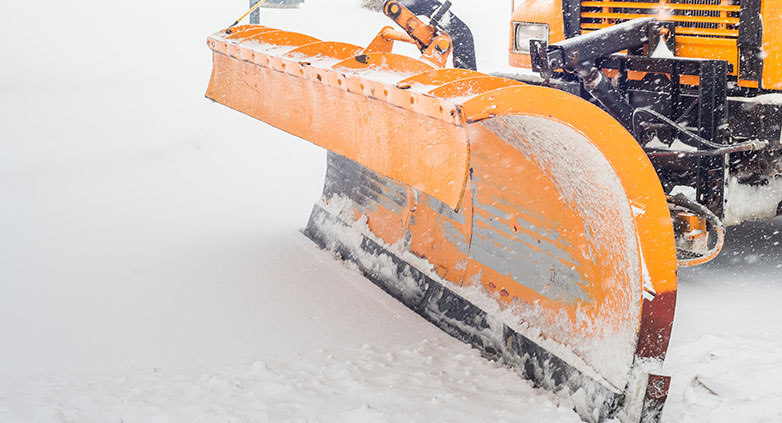Plowing on New Asphalt – How to Protect Your Surface in the winter
Unveil the critical strategies for plowing on new asphalt, ensuring your driveway remains unscathed through winter’s harsh conditions. Understanding the right techniques can make a significant difference in maintaining your asphalt’s integrity and appearance.
Plowing on new asphalt requires careful techniques to prevent damage. Use lightweight plastic shovels to avoid scarring the surface. Shoveling frequently and early helps prevent snow and ice accumulation, reducing the strain on the asphalt. Keeping the shovel at a steep angle minimizes direct contact, safeguarding the new pavement. In cases of ice, avoid aggressive tools like ice picks; instead, opt for gentle de-icing methods to maintain the integrity of your new asphalt.
Explore detailed strategies for protecting new asphalt during winter plowing. Learn how to balance effective snow removal with preserving your driveway’s longevity and appearance.
Risks of Having Driveway Plowed
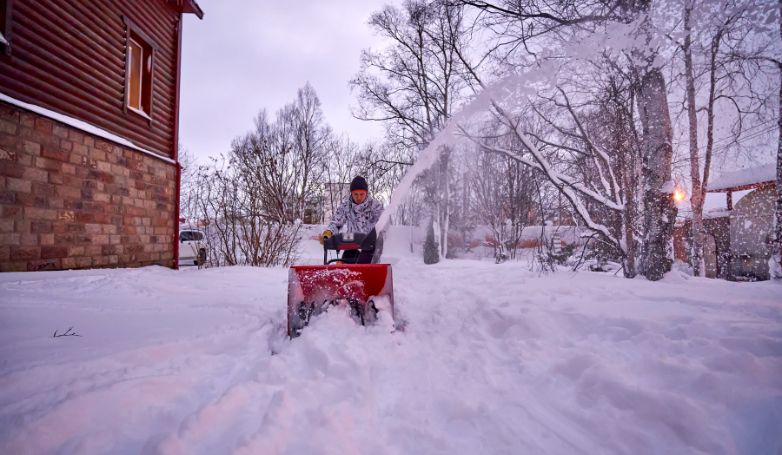
Winters are the toughest times of the year, perhaps, in terms of property and residence maintenance. Homeowners are constantly hard-pressed to prevent all kinds of damage to their properties, including protecting their asphalt driveways from plowing damages.
If you observe how snow plowing operates, you’d note the nigh risks of damage as the heavy metal blade drags across it repeatedly. It is even trickier if you have an uneven surface below or if the level is unclear to you.
Once the snow melts and spring approaches, you start discovering visible splits and gashes in the driveway. These are never a welcome sight. Let’s take a closer look at all the risks involved:
Hardscaping
If you have certain hardscaping elements, including pavers and bricks that are detaching or protruding, you have trouble on your hands. These are even more vulnerable to damage from shovels, and the heavy-duty equipment one has to employ to shovel snow.
Concrete
When undertaking the task of plowing on new asphalt, it’s important to be aware that certain cracks and chippings in the driveways may not be clearly visible, but they do exist. During this process, the salt used to melt snow and ice can penetrate these openings, corroding the steel reinforcements lying underneath the surface.
Asphalt
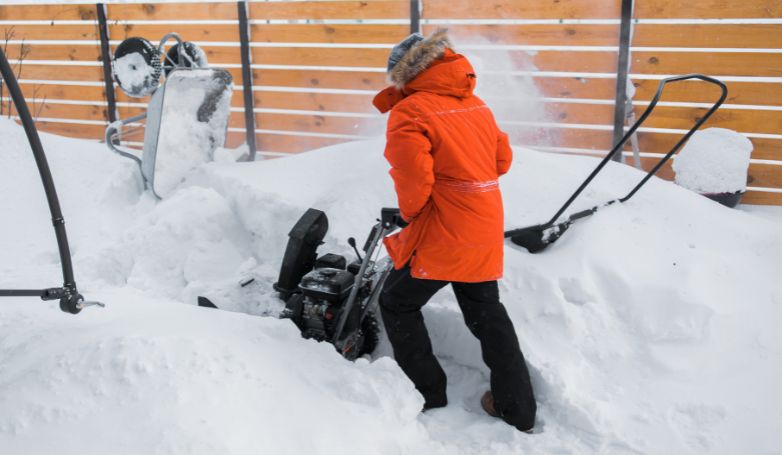
We know that asphalt is already brittle in texture, but this means that your driveway is even more prone to chipping. Hence, the subject of snow plowing and rigors from the shoveling will chip the driveway. It will suffer terrible damage as a result of rigorous plowing, and larger chunks of asphalt may come off altogether. It is also possible that such an occurrence will force you to repave the driveway.
Subsurface Water Damage
Snow plowing can exacerbate subsurface water issues. When snow is removed, the underlying water from melted snow can seep into small cracks or porous areas of the driveway. This water, upon freezing, expands, leading to larger cracks or even potholes. Regular plowing, by constantly exposing these areas to water and freezing cycles, can significantly accelerate the deterioration process, especially in driveways with pre-existing water drainage issues.
Edge Erosion
Edge erosion is another risk associated with driveway plowing. The repeated scraping of plows along the driveway edges can strip away the material, particularly in gravel or loosely bound surfaces. Over time, this leads to the gradual weakening and erosion of the driveway’s boundaries. The edges become more susceptible to crumbling, creating uneven surfaces and potentially leading to larger structural issues if not addressed promptly and maintained properly.
How to Avoid Damage while Plowing
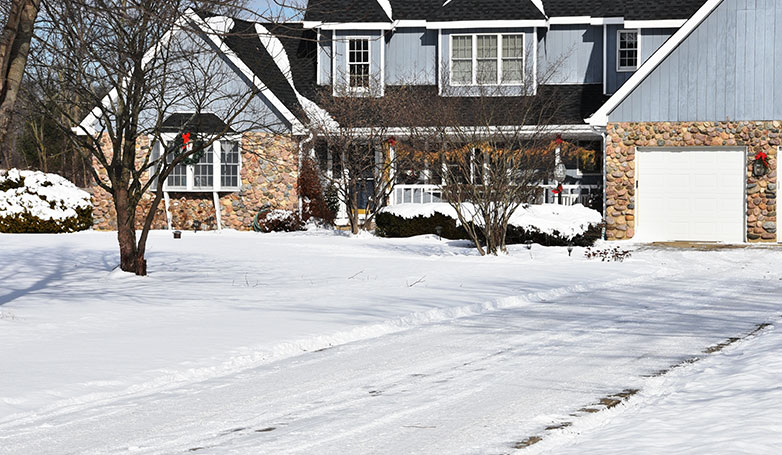
You can combat heavy snowfall in several ways, such as clearing parking lots, roads and maintaining asphalt before the snow descends. But how can one secure their asphalt from the distressing damage snow plowing causes, from the abrasive salt and the freeze-thaw cycles? We have answers for you below:
Sealing and filling cracks
The best way to prepare for plowing on new asphalt and the upcoming snow is to thoroughly inspect your driveway for any cracks and openings. Then, fill and seal those well before the weather turns cruel. If you fail to address the cracks and openings, you make room for damage to set in.
When you neglect to fill and sealing cracks, water will continue freezing and thawing in them all through winters. This will cause the cracks to widen and even spread into branches underneath. Water has to potential to penetrate under your damaged asphalt, and you can very well expect potholes and further cracking consequentially.
Opting for alternative deicers
You can opt for a more eco-friendly material for melting snow. These include calcium chloride, urea, and other friendly alternatives to rock salt. While they do have corrosive effects, these are comparatively less extreme than rock salt. You only need to maintain their application. However, you have found this option somewhat unattractive during stormy and rough windy weather.
Adjust Plow Blade Height and Angle
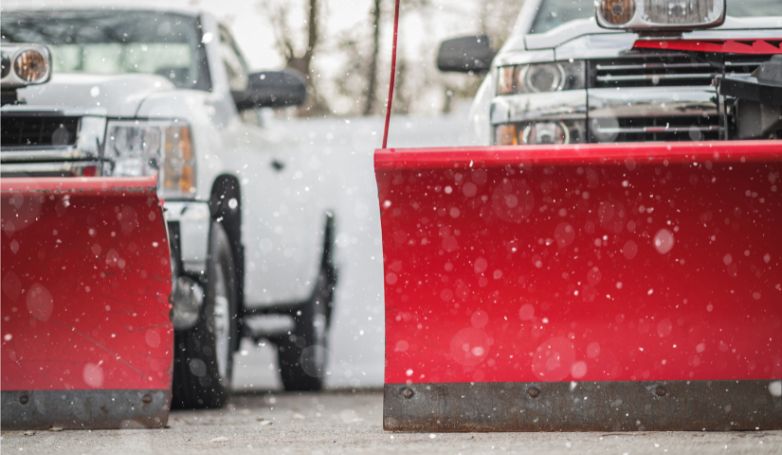
Properly adjusting the height and angle of your plow blade is crucial. Set the blade high enough to avoid scraping the driveway surface too harshly, yet low enough to effectively remove snow. An optimal angle ensures the snow is pushed aside efficiently without exerting excessive pressure on any part of the driveway. This balanced approach minimizes the risk of gouging or scraping, especially on softer surfaces like new asphalt.
Regular Driveway Inspections
Implement a routine of regular driveway inspections, especially during the winter months. Frequent checks for new cracks, uneven surfaces, or signs of wear can help you address issues before they worsen under the strain of plowing. Early detection and maintenance can prevent small problems from escalating, saving your driveway from severe damage that can result from plowing over compromised areas.
Snowblowing Instead of Plowing
Consider using a snowblower as an alternative to plowing on new asphalt in certain conditions. Snowblowers can be gentler on the driveway surface, especially suitable for residential properties with lighter snowfall. They offer more precise control over snow removal, minimizing the risk of accidental damage. This approach is particularly advantageous for driveways with decorative elements or intricate designs, which are more susceptible to damage from heavy plowing equipment.
Investing in Quality Solutions for Snow Removal
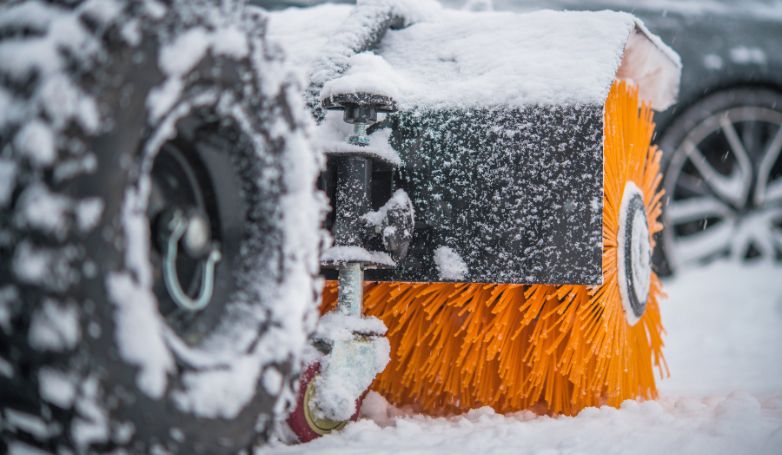
Many times, homeowners try to skimp extra costs by choosing inexperienced talent to plow snow from their driveway. We do understand how extra costs can put quite a strain on your budget but look at the positive side of it. Hiring experienced drivers from reputed companies will prevent you from incurring major repair costs later on.
Hence, the great idea is to set aside a sum all through the friendly months so that you can invest in hiring experienced and professional drivers in the tough winters. Their expertise will prevent damages to your asphalt and save you time as well.
You can hire a reputable company or contractor to take care of snow removal. They can assess your property and identify damage and scraping that may have occurred by less experienced snowplow drivers. You could also map out a special track for the winters to set and establish markers for drivers to spot entranceways and curbs easily.
Consider heated driveway mats
We believe these are the most hassle-free options for plowing on new asphalt. The mats are energy efficient, allowing you to set them and forget them. Designed to endure winter conditions, they are durable enough for cars to drive over and come with a remote-controlled option, enabling you to manage them from indoors.
Budgeting for Pavement Preservation and Rejuvenation

Once the ice and snow start melting away, use a sealant for restoring the pavement back into a smooth surface. Invest in high-quality preservation and rejuvenation liquid that has an asphalt bead emulsion, penetrating chemistry, and special technology for locking the asphalt resins.
Such a product will help preserve, rejuvenate and preserve your asphalt pavements.
Heated Driveway Installation
This is a highly expensive option but also an effective and luxurious one. It keeps your driveway clear all through the winter months and your asphalt free from any snowplow damage.
Snow Blower Blades
Plowing on new asphalt demands precision and extreme carefulness. To this end, you must keep from chipping your asphalt, despite rigorous shoveling by holding your snow plower’s blades at least an inch or half above the asphalt. This way, the surface will not come directly into contact with the brutal blades and keep the surface safe.
Regular Maintenance Contracts
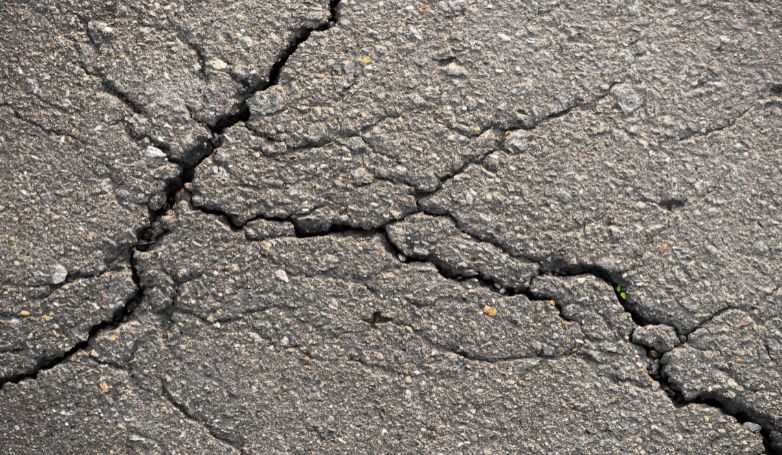
Budgeting for regular maintenance contracts with professional paving services can be a cost-effective strategy. These contracts typically include periodic inspections, sealing, minor repairs, and advice on pavement care. By investing in regular maintenance, you can prevent major damages that lead to expensive repairs or replacements. This proactive approach not only preserves the pavement but also spreads the cost over time, making it more manageable within a budget.
Quality De-icing Materials
Allocating funds for high-quality de-icing materials can be a wise investment. While these materials might be more expensive upfront compared to traditional rock salt, they are less damaging to your pavement and surrounding environment. By using materials that are less corrosive and more effective at lower temperatures, you can reduce the frequency and severity of pavement damage, leading to long-term savings in repair and maintenance costs.
Investing in Pavement Protection Products
Consider allocating a portion of your budget for advanced pavement protection products when planning for plowing on new asphalt. High-grade sealants or permeable surface treatments offer an additional layer of protection against the elements, diminishing the effects of snow, ice, and water infiltration. Although the initial cost may be higher, these treatments can greatly prolong your pavement’s lifespan, ultimately reducing the long-term expenses linked to frequent repairs or premature replacements caused by weather-related damages.
How to Properly Deal with Snow Removal on New Asphalt Surface
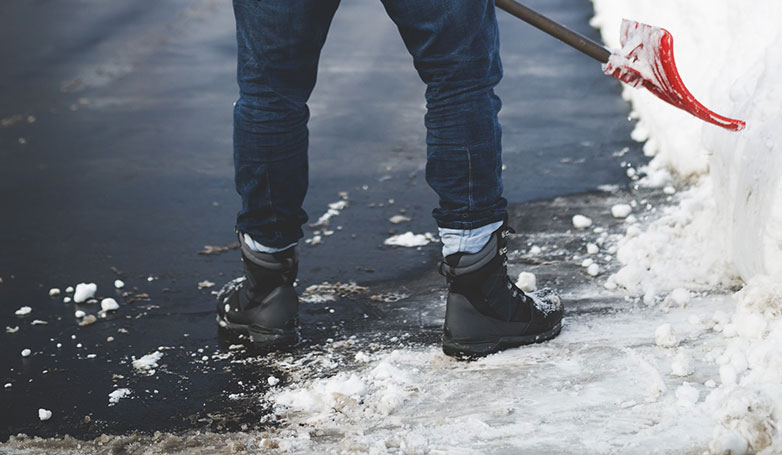
Being a naturally porous substance, asphalt can absorb more water from our environment. During winters, water has a greater ability to penetrate asphalt. Thus, it expands and freezes the driveway underneath. This creates even more cracks and plenty of other problems for homeowners.
Here are some shoveling tips for new asphalt surfaces in the winters:
Refrain from Metal Shovels
The number one enemy of asphalt driveways, especially the newer ones, is a metal shovel. It can damage your asphalt like anything, so the best thing to do is to use a lightweight plastic shovel for plowing the snow.
Even with the lightweight plastic variety, we recommend holding the shovel at a shallow angle and ensuring you protect the driveway from the shoveling action. Aim for a steep angle when gripping and moving the shovel to dig through.
Keep Your Eyes Open for Asphalt Failure

You may think your driveway is new, and hence right now, there is no need to be overly vigilant for it. In truth, it is all the more important to keep a close eye on your asphalt driveway and watch out for signs of potholes or miniature cracks.
Newly laid asphalt driveways must not suffer any damage till they have serviced you for at least a satisfactory period. Hence if you discover a crack in the early period, it could be indicative that you are not following proper maintenance protocols or that your structure is not as sturdy as it should have been.
Be Selective Regarding De-ices for Snowplowing
Deicers are somewhat relentless on asphalt, so you need to be very careful when using them. It is best to entirely skip the deicers but if you cannot do that, then at least try avoiding the rock salt variety.
Rock salt has a very damaging and toxic nature and also loses efficacy for temperatures below 15 degrees Fahrenheit. You could opt for the friendlier versions instead, such as magnesium chloride and others. These stay effective even for temperatures below zero degrees Fahrenheit.
Your next best option is calcium magnesium acetate, which works well even for temperatures like minus 25 degrees Fahrenheit.
Snow Blowing- Best Option for Snow Removal
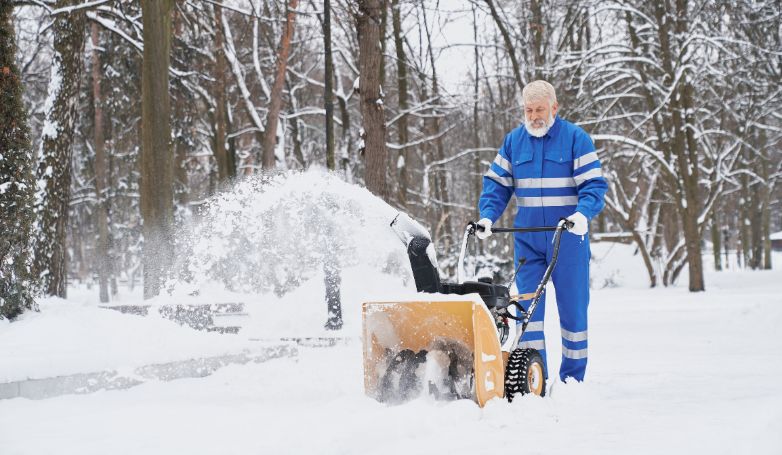
Homeowners who lack the time or ability to shovel their driveways themselves often face the challenge of delayed snow removal, which can be particularly problematic when plowing on new asphalt. For these individuals, it is especially beneficial to hire professional snow removal services to prevent the accumulation of issues and ensure the proper maintenance of their driveways.
Efficient and Safe Snow Removal with Snow Blowers
Snow blowing is extremely safe for removing snow and ice off your driveways. Snow blowing is actually a machine, which an experienced individual operates from behind, or if it is a larger one, then a power unit controls the machine.
A spiral, rotating blade removes the snow by propelling it upwards and on to the side. Today, this machine has evolved into a variety of models and features in the market, and you can pick one that fits your personal needs.
The best advantage of using a snow blower is that it comes in compact sizes too, and you can store it easily in tight areas during the off-seasons. The snowblower also operates on the ground level. Hence the person behind it can see everything around the front and around even while operating the machine.
It features hands-on control, so you get additional safety features and rest secured that no untoward accident will occur while plowing the snow. Snow blowing also gets the job done far quicker than manually shoveling snow and especially from narrow areas, like walkways, etc. time efficiency and safety are the highlights of snowplowing.
Salts and Deicers- Can they Damage asphalt?
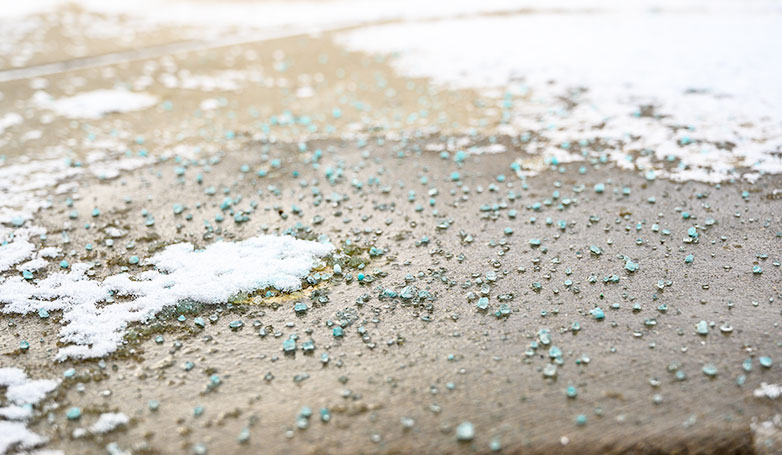
Generally speaking, deicers or salts do not primarily cause direct damage to the asphalt or deteriorate it. However, there are certain indirect effects it gives rise to that necessitate using the salts very sparingly or avoiding them altogether. Let’s look at those below:
- The freeze-thaw cycle rives root to pothole formation and certain damage resultantly. It exacerbates the use of salts and other deicers. The compounds contribute by lower the freezing water point and keeping it in liquid form, even in colder temperatures, to reduce icing. Unfortunately, the result of this is a more active freeze-thaw cycle.
- Asphalt is much better than light-colored concrete at melting ice and snow naturally. If you subject it to heavy salts or chemical infused deicers, you destroy the asphalt’s natural tendency to melt ice faster. Asphalt is a darker compound; hence it has the ability to absorb more sunlight and get even hotter. This is why it works better without deicers and salts at melting winter snow.
- When the snow melts and the salts or deicers run in liquid forms, they seep into the soil and run into storm drains. Eventually, these land into the local water bodies and damage plant and animal life.
The Effect of Cold Weather on Asphalt (Freeze/thaw cycle)

The winter months mean frigid, brutal temperatures that can ruin asphalt in a number of ways. This season features constant thawing and freezing, also what we refer to as the freeze-thaw cycle that creates cracks and other damages in our driveway.
In this condition, we must pay due attention to the external forces as they necessitate asphalt repairing. Because cold and low temperatures are constant all through winters, the asphalt is more prone to contracting.
This contraction frequency is what causes the cracks and significantly weakens the asphalt from the surface till deep inside. It is no surprise how such instances sharply reduce the life expectancy of our asphalt surfaces.
Hence, we stress the importance of repair as invaluable to maintaining the integrity of your asphalt, despite the cold weather.
Conclusion
Plowing on new asphalt is nothing short of a challenge each year. Any negligence or improper approaches can damage not only the surface of our asphalt driveway but penetrate right through it and cause more troubles.
From snowplowing to using lightweight plastic shovels, it is of utmost importance to use the right tools and techniques for shoveling ice and snow each year. Apart from this, regular checks and timely repairs are necessary to maximize the life expectancy and soundness of our asphalt driveways by a far measure.

